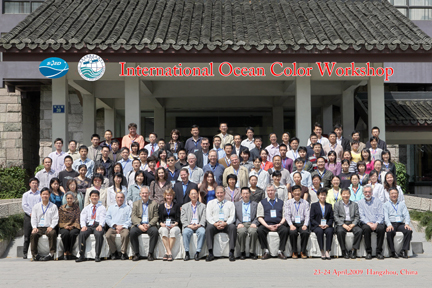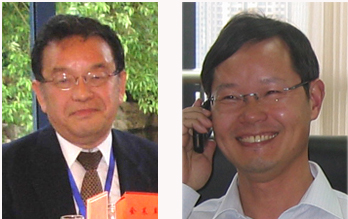

|
|
 Participants of the International Ocean Colour Workshop, Hangzhou, China (23-24 April 2009) (Click on image for larger view)
The IOCCG-14 meeting was followed by an International Ocean Colour workshop (23-24 April 2009), which was attended by many young ocean-colour scientists from the area as well as IOCCG Committee members. The agenda for the workshop, plus all the presentations can be viewed at:  Three members of the IOCCG Committee rotated off at the end of the IOCCG-14 meeting: Pan Delu (Scientific Representative, China), Srinivasa Kumar (Scientific Representative, India) and Heidi Sosik (Scientific Representative, USA). IOCCG extends its thanks to these individuals for the time they have invested in IOCCG activities. Two new Scientific Representatives have been appointed to the IOCCG Committee and are warmly welcomed: Tasuku Tanaka (Scientific Representative, Japan) and Zhihua Mao (Scientific Representative, China). The current IOCCG Chairman, Prof. James Yoder, will complete his term of service in January 2010, so nominations for a new Chairman were discussed at the Executive meeting, and Dr. David Antoine (LOV, France) was elected as the upcoming IOCCG Chair. Congratulations to David on his election as IOCCG Chairman for 2010.
A number of algorithms have been developed over the years for retrieving Inherent Optical Properties (IOPs), i.e. the scattering and absorption characteristics of water and its constituents, via remote sensing of ocean colour. Many of these algorithms were reviewed in IOCCG Report 5. The Quasi-Analytical Algorithm (QAA) of ZhongPing Lee et al. was recently updated to reflect the latest findings. A full description of these updates can be found at http://www.ioccg.org/groups/Software_OCA/QAA_v5.pdf along with an Excel template (see:
Inversion Procedures in Ocean-Colour Remote Sensing: An advanced training course/workshop on inversion procedures will take place from 10-14 August 2009 in Lauenberg, Germany, organised by Dr. Roland Doerffer (GKSS Research Centre), in conjunction with the IOCCG. The objectives of the workshop are to provide participants with an overview of inversion methods and models, as well as the preparation of bio-optical models and training data sets for inversion methods. Participants should have a strong mathematical background as well as experience in programming. See course announcement for further details. Training Course in Tanzania: The Joint Research Centre (EC), in conjunction with the Institute of Marine Sciences, University of Dar-es-Salaam (Tanzania), is offering a training course on "Methods and Applications of Ocean Colour Remote Sensing in African Coastal and Regional Seas". The course will take place from 12 - 23 October 2009 at the University of Dar-es-Salaam, Stone Town, Zanzibar, Tanzania and will be co-sponsored by several organisations, including the IOCCG. The course is intended for scientists from all African and Western Indian Ocean countries. Further information on the course, plus the necessary Application Forms are available on the training course website at: http://amis.jrc.ec.europa.eu/oc2009africa.php.
An intensive graduate level course entitled "Phytoplankton Community Structure: From the Molecular to the Global Scale" will be offered at Instituto de Estudos do Mar Almirante Paulo Moreira, Rio de Janeiro, Brazil from 21 September to 7 October 2009. The rationale for the course is that partitioning the autotrophic plankton community into functional types is expected to improve the modelling of primary production and increase our understanding of the role of phytoplankton in the global carbon cycle. The course is part of a training program undertaken by the Nippon Foundation-POGO Center of Excellence in Observational Oceanography at the Bermuda Institute of Ocean Sciences (BIOS), whose objectives are “to expand world-wide capacity to observe the oceans; to develop human resources in developing countries, and to expand international networking in ocean sciences, with an emphasis on training young scientists from developing countries”. This initiative is also a contribution to ANTARES, an integrated network of in situ and remote-sensing stations focused on detecting long-term changes in marine waters around Latin America. The course is open to a limited number of participants (~15) from Latin America. For further information, please see the course announcement. |
NASA's SeaDAS group recently released a fully functional version of SeaDAS that will run on Windows platforms. This is a major accomplishment which should significantly broaden the accessibility of satellite data processing and analysis to a much larger user community. The SeaDAS Virtual Appliance - SeaDAS VA 5.3b (beta) - allows Microsoft Windows users to run SeaDAS on their systems within a virtual Linux machine. The appliance runs on Windows XP and Vista systems and includes a fully functional version of SeaDAS within a streamlined Linux environment. Installation is extremely simple and requires no knowledge of Linux. One might expect SeaDAS to run much slower in a virtual environment, but performance results indicate that SeaDAS VA runs nearly as fast as a standard installation. NASA requests your feedback to help further improve the package. To download NASA's SeaDAS Virtual Appliance (beta), go to: http://oceancolor.gsfc.nasa.gov/seadas/.
All the presentations from NASA's 2009 Ocean Color Research Team Meeting (4-6 May 2009, New York City) are now available on-line with the agenda. See NASA's Ocean Color Web.
A very successful User Workshop for the new ESA CoastColour project was held in Cork, Ireland (19-20 March 2009). Presentations from the meeting can be found at: http://dup.esrin.esa.it/news/news176.asp. The objective of the Project is to increase the global user uptake of advanced information products from ESA's MERIS mission by developing, demonstrating and validating the latest techniques for monitoring water constituents in coastal zones around the world. The project is now soliciting "Champion Users" to provide a specification of the user requirements, plus advice and user feedback during the execution of the project. For information on past ESA/DUE projects see: http://www.esa.int/due.
Four new GlobColour demonstration products have been generated for testing and user feedback, and are now available.
For further information regarding these parameters, see the GlobColour demonstration products page: http://www.globcolour.info/data_access_demo.html, or go directly to the HERMES server: http://hermes.acri.fr/.
ESA's 2nd Advanced Training Course on Ocean Remote Sensing will take place in Bergen, Norway from 28 September to 2 October 2009. This advanced training course will focus on ocean remote sensing theory and applications. It will address both Radar and Optical/Thermal remote sensing. As an advanced training course, it is targeted to the European, ESA Member state and Canadian research and development community, in particular post-doc researchers as well as masters and PhD students. The deadline for registration is the 30 June 2009. For further information see http://earth.esa.int/Ocean2009.
The authors found that the length of the egg incubation period, and hence the timing of the hatch, was strongly dependent on local bottom water temperatures. Timing of the spring bloom, however, is influenced by surface temperatures and available sunlight. In the southern Gulf of Maine, the waters are relatively warm and shrimp eggs take ~6 months to hatch, while in the cold waters off Northern Iceland the eggs take 9-10 months to hatch. This suggests that the time of mating must have evolved so the larvae are ready to hatch near the time of the bloom, under average temperature conditions for each area. This study has demonstrated the evolutionary plasticity of an important marine species adapting to distinct environmental conditions across its range, and provides a framework for discussion of how shrimp stocks, and possibly other economically and ecologically important species, might respond to climate change. The shrimp stocks will be affected by changes in both the timing of the spring bloom and bottom temperatures, and a decoupling of the match between larval hatching and timing of the spring bloom may arise if the interacting environmental factors are driven by different oceanographic processes.
Several new positions have been added to the Employment Opportunities section of the IOCCG website, including a Research Associate position at the City College of City University of New York (CCNY), a PhD Fellowship on the development of a new algorithms to process satellite ocean colour data in coastal waters at the Université du Littoral-Côte d'Opale (France), and a remote sensing Faculty Position in Oceanography at the Institut des Sciences de la Mer de Rimouski (Canada).
|
|
|
Material for possible inclusion in the IOCCG Newsletter should be submitted to the Project Scientist. Subscription to the IOCCG Mailing List.Participants receive a brief summary of the IOCCG Newsletter by e-mail (quarterly), as well as hard copies of IOCCG Reports as, and when, they become available.
|
|
|